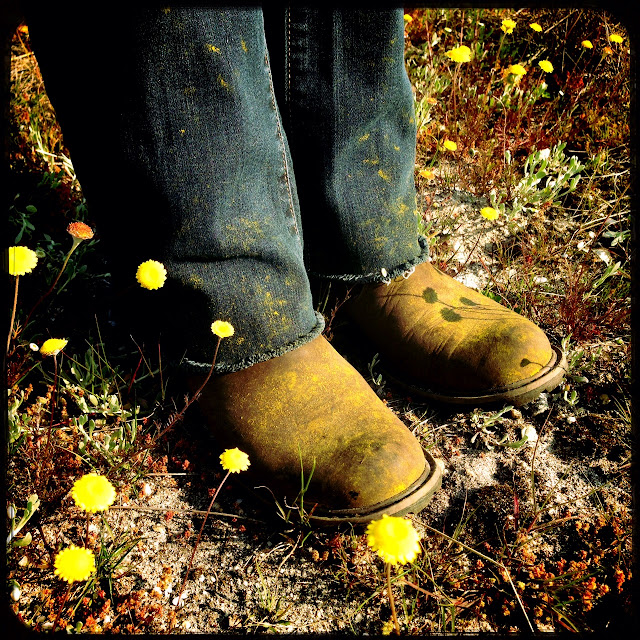Some weeks ago, we went for a walk at Redhill.
We walked through fields of spring flowers,
doing some pollination of our own.
At the first ruined house, we saw two scruffy men with metal detectors and decided to give them a wide berth.
At the second ruin, I picked up some bits of striped Corning Ware and slipware. Evidence that there were kitchens here once,
meals eaten, conversation.
 |
| (Redhill photos by the tallest man.) |
We found a crumbling old cemetery further up the hill, very small. Someone had planted white freesias on a grave here many years ago - they were straggly, but filled the air with their scent. Synapses fired in my brain: Grandmother. Birthday.
We noticed a marshy field rippling like some green ocean, filled with watsonias about to bloom.
On our way back we bumped into the men with the metal detectors and this time we stopped to talk. They wanted to know what we were looking for and tried very hard to convince us to buy metal detectors: You'll never look back!
We've never liked the idea of digging for something though - preferring to glean what is lying on the surface. One of the men told me that in his diving days he had found lots of Ming under the sea.
You know the blue and white stuff?
(!)
And then he said: I found a piece of Ming today - hold on!
He rooted through the small canvas bag tied around his waist. A ball of wire/ bottle tops/ a rusty nail. Here you are! and he handed me a lovely little piece of Staffordshire transferware.
His friend presented me with an old jam jar lid.
Salty sea dogs they were, but very sweet. Since then we call all the porcelain shards that we pick up Ming.
As we walked off the one said to the other: Come on, let's go cause some more kak somewhere else.
In Churchaven we pick up bits of Willow Pattern, green transferware and pink. Slipware. Old medicine bottles.
Over the years, we've picked up many, many pieces of a particular blue-grey pattern. In my mind I call it the-eyes-and-nose, because of the distinctive inner border. Last time I picked up a shard in the lagoon, with some sea-life attached.
Rooting through a little antique shop in Wynberg, as I do, I noticed that exact same edge peeping out from beneath a small dresser. A heart stopping moment!
Rhine. An old Samuel Alcock design, inherited by Burgess & Leigh and made by J.F.W.Foley Potteries in Staffordshire between 1822 and 1853.
Funnily enough, they also produced Asiatic Pheasant, a lovely pale blue and white pattern, which we also find bits of now and then.
Needless to say, the meat platter ended up in the tall man's birthday box and now hangs in our hallway under the portrait of his Great Grandfather, who was a commander in the Boer War.
Back at home, while we were away, the robins built another nest. Of two eggs, one hatched.
Today the nest is empty.
Another robin flies out into the big wide world.












